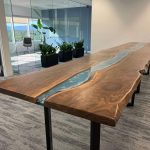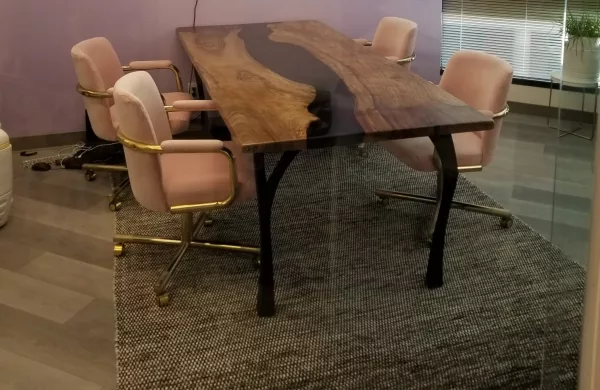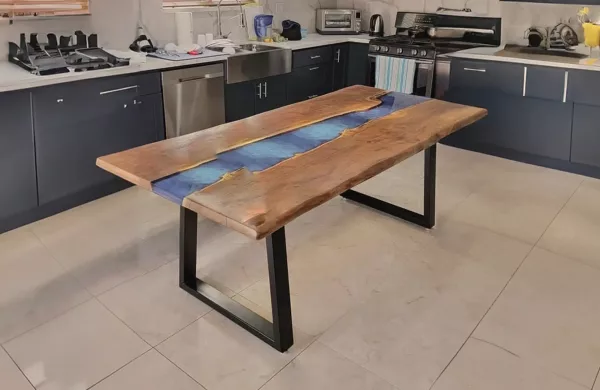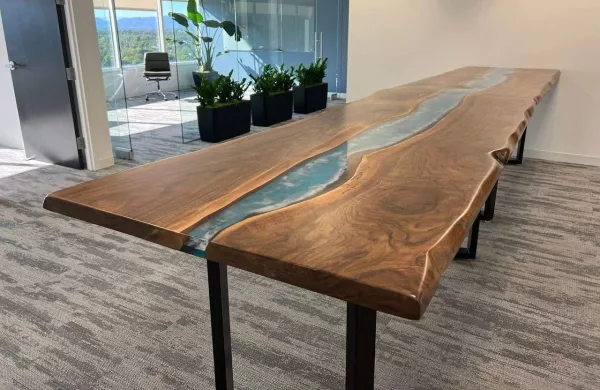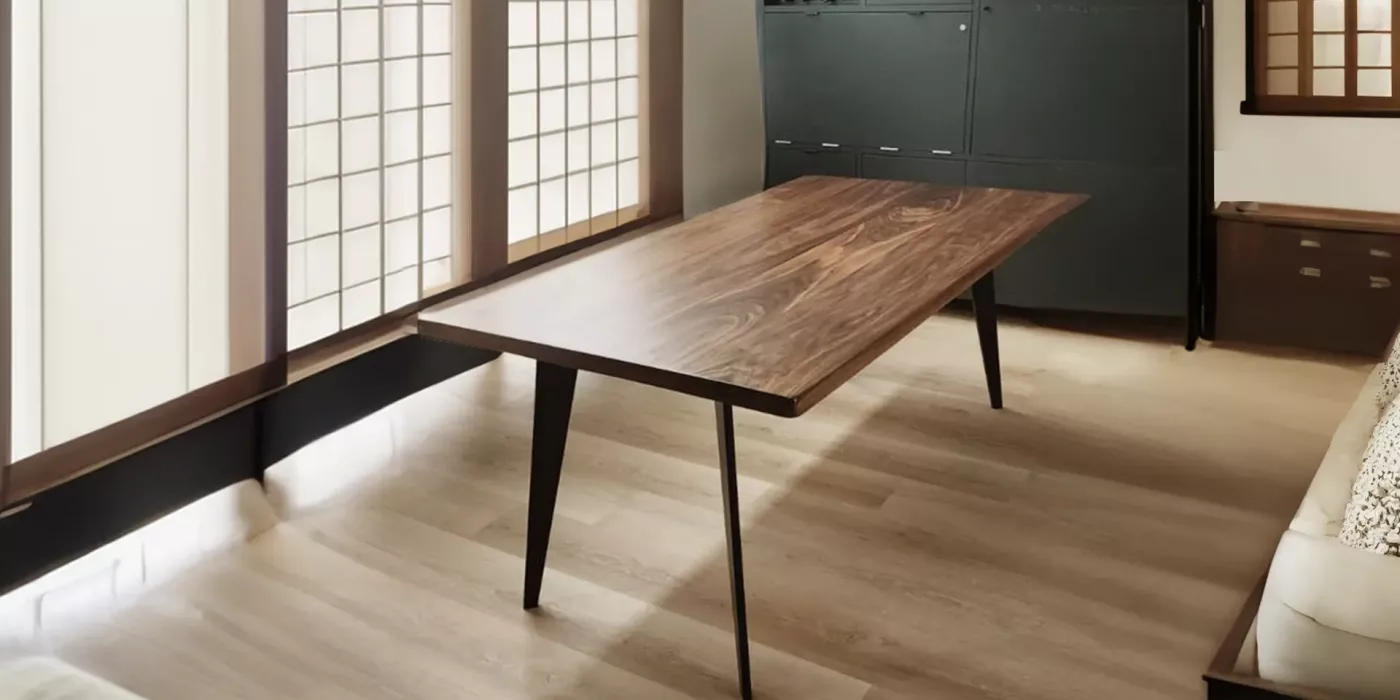
Selecting the best type of wood for an office table involves balancing aesthetics, durability, and budget. Here are some top choices, each offering unique benefits:
1. Pros & Cons of Oak for office table
Oak is a popular choice for office furniture, including tables, due to its durability, aesthetic appeal, and the warmth it brings to any office space. Here’s a detailed look at the pros and cons of using oak for an office table:
Pros:
- Durability and Strength: Oak is known for its exceptional strength and durability. It can withstand the rigors of daily use, making it ideal for a busy office environment. An oak office table can last for decades with proper care.
- Aesthetic Appeal: Oak wood has a beautiful natural grain that adds texture and character to office decor. It can be finished in a variety of stains and lacquers, allowing for versatility in design. Whether you’re aiming for a classic, rustic, or contemporary look, oak can be adapted to suit your style.
- Timelessness: Oak furniture has a timeless quality, meaning it won’t go out of style. This makes it a wise investment for offices that want furniture that will look great and be functional for many years.
- Resistant to Fungus and Pests: Oak’s density makes it naturally resistant to fungal and pest attacks, which contributes to its longevity and durability.
- Variety: Oak comes in several varieties, including red and white oak, each offering slightly different hues and grain patterns. This variety allows for customization and matching with different office interiors.
Cons:
- Weight: Oak is a very heavy wood, which can make an oak office table difficult to move. This might be a consideration for offices that frequently reconfigure their layouts.
- Cost: High-quality oak furniture tends to be more expensive than pieces made from softer, less durable woods. The initial investment may be higher, although the durability of oak can offset this cost over time.
- Maintenance: While oak is durable, it still requires regular maintenance to keep it looking its best. This includes periodic polishing and protection from spills and heat, which might be a consideration in a busy office.
- Prone to Scratches: Although oak is hard and durable, its surface can still be prone to scratches and dents if not properly cared for. This means that items like pens, keyboards, and desk accessories could potentially mar the surface over time.
- Susceptibility to Changes in Humidity: Like all wood, oak can expand and contract with changes in humidity. In environments with wide fluctuations in moisture, an oak table might warp or crack, requiring a controlled climate to maintain its shape.
2. Pros & Cons of Maple for office table
- Maple is another excellent choice for office furniture, known for its durability and versatile aesthetic appeal. Here’s a breakdown of the pros and cons of choosing maple for an office table:
Pros:
- Durability and Hardness: Maple is one of the hardest wood types, making it extremely durable for office use. It can handle heavy loads and resist wear and tear from daily activities, making it ideal for a long-lasting office table.
- Aesthetic Versatility: With its light natural color and fine, uniform grain, maple offers a clean and contemporary look. It can be stained to match a variety of decor styles, from modern minimalist to traditional.
- Resistance to Scratching and Denting: Due to its hardness, maple is more resistant to scratches and dents compared to softer wood types. This resistance makes it suitable for high-traffic areas and demanding office environments.
- Sustainability: Maple trees are abundant in North America, making maple wood a more sustainable option than some exotic woods. Choosing maple can be part of an environmentally responsible purchasing decision.
- Easy to Maintain: Maple’s smooth surface is easy to clean and maintain, requiring only regular wiping to remove dust and occasional polishing to keep it looking new.
Cons:
- Price: High-quality maple wood can be on the expensive side due to its many desirable qualities. However, the investment might be justified by its durability and longevity.
- Susceptible to Humidity: Like most woods, maple can be affected by changes in humidity, potentially warping or cracking if not properly cared for. This can be a consideration in climates with significant seasonal changes.
- Shows Stains and Marks: Light-colored maple wood can show stains, spills, and marks more easily than darker woods. This requires prompt cleaning to prevent permanent discoloration, especially in an office setting where spills might occur.
- Limited Color Variation: While the uniform grain and light color of maple are appealing to many, those looking for a wood with more natural color variation or a darker tone might need to rely on stains, which can alter the natural beauty of the wood.
- Weight: Maple is a dense, heavy wood, making furniture made from it cumbersome to move. This could be a drawback in offices that frequently rearrange or update their layout.
When considering maple for an office table, it’s important to weigh these factors against the specific needs and style of your office. Maple’s durability, light color, and modern appeal make it a popular choice for those seeking a long-lasting, stylish office table that can withstand the rigors of daily use.
3. Pros & Cons of Cherry for Office Table
- Cherry wood is another distinguished choice for office furniture, offering a unique combination of aesthetic appeal and functional benefits. However, like all materials, it has its set of considerations. Here’s an overview of the pros and cons of using cherry for an office table:
Pros:
- Rich Color and Aging: Cherry wood is renowned for its rich, warm hues that deepen into a lustrous reddish-brown patina over time when exposed to sunlight. This aging process adds character and elegance to the furniture, making a cherry office table a piece that improves with age.
- Fine Grain and Smooth Finish: Cherry has a fine, straight grain pattern that gives it a smooth finish and sophisticated look. This makes it ideal for high-end executive offices where appearance is paramount.
- Strength and Durability: While not as hard as maple or oak, cherry wood still offers good durability and strength for everyday office use. It’s sufficiently resilient for a desk surface, capable of supporting heavy books, equipment, and daily tasks.
- Workability: Cherry wood is relatively easy to work with, allowing for intricate designs and detailed craftsmanship. This makes it possible to have custom-designed office tables with unique features or ornate detailing.
- Eco-friendly Option: Cherry trees are abundant in the United States and are managed sustainably. Choosing cherry wood furniture can be a more environmentally friendly option, supporting local economies and reducing carbon footprints.
Cons:
- Cost: Cherry wood is considered a premium hardwood, which means furniture made from cherry can be more expensive than those made from more common woods. This higher cost is due to its quality, durability, and the aesthetic appeal of the wood.
- Prone to Scratching and Denting: Cherry wood is softer compared to some other hardwoods like oak and maple, making it more susceptible to scratches and dents. In a busy office environment, this could mean more visible wear and tear over time.
- Sensitive to Light: The color of cherry wood deepens when exposed to sunlight, which, while often a desired effect, can lead to uneven coloring if the table is partially covered or if certain areas receive more light than others.
- Maintenance: To preserve its rich color and smooth finish, cherry wood may require regular maintenance, including oiling and polishing. This might be considered a con for those looking for a low-maintenance office table.
- Weight: Cherry wood furniture can be quite heavy, making it challenging to move. This might be a consideration for offices that anticipate needing to rearrange or relocate furniture frequently.
When choosing cherry wood for an office table, consider the balance between its beautiful aging process and the care required to maintain its appearance. The warmth and elegance of cherry can elevate the look of an office space, making it a popular choice for those who prioritize aesthetics and are willing to invest in its upkeep.
4. Pros & Cons of Walnut for Office Table
- Walnut is a luxurious choice for office furniture, known for its rich color and beautiful grain patterns. Like all materials, however, it has its advantages and disadvantages. Below are the pros and cons of using walnut for an office table:
Pros:
- Aesthetic Appeal: Walnut wood has a rich, dark color that ranges from light brown to a deep chocolate hue, often with beautiful, intricate grain patterns. Its natural elegance makes it a preferred choice for high-end, stylish office environments.
- Durability: Walnut is a hard, dense wood, making it durable and resistant to wear and tear. This means a walnut office table can withstand the demands of daily use, maintaining its integrity over time.
- Unique Character: Each piece of walnut wood is unique, offering distinctive grain patterns and color variations. This means that every walnut office table is one-of-a-kind, adding character and exclusivity to an office space.
- Works Well with Finishes: Walnut wood takes well to stains and finishes, allowing for a range of appearances from natural to polished and refined. This versatility can match various office decors, from traditional to contemporary.
- Aging Gracefully: Walnut wood ages beautifully, often developing a richer patina over time. Unlike other woods that might degrade or look worn, walnut furniture tends to gain character and aesthetic value as it ages.
Cons:
- Cost: Walnut is considered a premium hardwood, which can make it more expensive than other wood options. The higher cost is due to its quality, durability, and the elegance it brings to furniture.
- Weight: Being a dense and solid wood, walnut furniture can be quite heavy. This might make moving or rearranging a walnut office table more challenging than lighter wood alternatives.
- Scratches and Dents: While durable, walnut’s surface can still be susceptible to scratches and dents, especially in lighter finishes. These marks may require professional repair to maintain the table’s aesthetic appeal.
- Light Sensitivity: Walnut wood can lighten over time when exposed to direct sunlight. This fading can be a consideration if the office receives a lot of natural light, as it may lead to uneven coloring if parts of the table are regularly covered.
- Availability: High-quality walnut can be less readily available than more common woods like oak or pine, potentially leading to longer wait times for custom pieces or higher prices due to its scarcity.
Choosing walnut for an office table is often a decision driven by a desire for luxury, style, and a statement piece that adds warmth and character to an office space. While it requires an investment, both in terms of cost and maintenance, the timeless elegance and durability of walnut can make it a worthwhile choice for those looking to create a sophisticated and inviting office environment.
5. Pros & Cons of Pine for office table
- Pine wood offers a distinct choice for office furniture, bringing a blend of rustic charm and practicality. It’s important to consider both the advantages and disadvantages when contemplating pine for an office table:
Pros:
- Affordability: Pine is more affordable compared to hardwoods like oak, walnut, or cherry. This makes it an attractive option for budget-conscious buyers looking for quality furniture without the high price tag.
- Lightweight: Compared to hardwoods, pine is relatively lightweight, making furniture easier to move or rearrange within an office space. This can be particularly advantageous in dynamic environments that require frequent layout changes.
- Aesthetic Versatility: Pine has a light color with a visible grain pattern, offering a neutral base that can easily be painted or stained to match any office decor. Its natural look lends well to both modern and traditional designs.
- Sustainability: Pine grows quickly and is widely cultivated in managed forests, making it a more sustainable option than some slow-growing hardwoods. For environmentally conscious buyers, pine represents a responsible choice.
- Workability: Pine wood is easy to work with, allowing for a variety of designs and customizations. This makes it possible to create unique or bespoke office tables tailored to specific needs or preferences.
Cons:
- Durability: Pine is a softwood, which means it’s less durable than hardwoods. It can be prone to scratches, dents, and wear over time, especially under heavy use. This may not be ideal for an office table that needs to withstand daily tasks and equipment.
- Maintenance: Due to its softer nature, pine furniture might require more maintenance to keep it looking its best. It may need regular refinishing or touch-ups to repair scratches or marks.
- Staining Unevenly: Pine can sometimes absorb stains unevenly due to its porous nature, leading to a blotchy appearance. A professional finish is recommended to achieve a uniform look, which could add to the cost.
- Swelling and Shrinking: Pine wood can be sensitive to changes in humidity, leading to swelling or shrinking. This can affect the stability and fit of the office table, especially in environments with significant seasonal climate changes.
- Less Formal Appearance: While pine’s natural and rustic look can be appealing, it might not convey the same level of professionalism or elegance as some darker hardwoods. This could be a consideration for businesses that aim for a more formal office atmosphere.
Choosing pine for an office table can offer both aesthetic and practical benefits, particularly for those seeking a cost-effective and flexible option. However, considerations around durability and maintenance are important to ensure that the table remains functional and appealing over time. Balancing these factors against the specific needs and style of your office will help determine if pine is the right choice for your office table.
6. Pros & Cons of Bamboo (Technically a Grass) for Office Desk
- Bamboo is an increasingly popular material for office furniture, including desks, due to its sustainability and distinctive appearance. While technically a grass, bamboo offers many of the benefits of hardwoods and has unique characteristics that make it a compelling choice for an office desk. Here are the pros and cons of using bamboo for this purpose:
Pros:
- Eco-Friendly: Bamboo is highly sustainable; it grows rapidly, reaching maturity in just 3 to 5 years compared to hardwoods, which can take decades. This rapid growth cycle and the fact that bamboo can be harvested without killing the plant make it an environmentally friendly resource.
- Durability: Despite being a grass, bamboo is incredibly strong and durable. Some types of bamboo have a higher tensile strength than steel, and bamboo furniture can withstand wear and tear, making it suitable for daily use in an office environment.
- Aesthetic Appeal: Bamboo has a unique, natural look that can add warmth and style to any office setting. Its grain patterns are distinct and can complement both modern and traditional decor.
- Lightweight: Bamboo furniture is generally lighter than those made from hardwoods, making it easier to move and reconfigure office spaces as needed.
- Resistant to Moisture: Bamboo is more resistant to water damage than many types of wood. This makes a bamboo office desk more resilient against spills, which are inevitable in a busy office environment.
Cons:
- Variability in Quality: The quality of bamboo can vary significantly depending on the manufacturing process. Some bamboo furniture may be made from lower quality material or constructed using less durable methods, affecting its longevity and performance.
- Scratches and Dents: While durable, the surface of bamboo furniture can be prone to scratching and denting, especially from sharp objects or heavy equipment. This might require the use of desk pads or mats to protect the surface.
- Limited Styles and Finishes: Bamboo desks tend to have a distinctive look that might not suit every office decor. There are also fewer color and finish options available compared to traditional wood desks, which might limit design choices.
- Swelling and Shrinking: Although resistant to moisture, bamboo can still react to changes in humidity by swelling or shrinking. This could potentially affect the stability and alignment of desk components over time.
- Cost: While bamboo is often touted as a cost-effective option, high-quality bamboo furniture can come with a premium price tag, especially for items that have undergone a more rigorous manufacturing process to ensure strength and durability.
Choosing bamboo for an office desk brings a combination of sustainability, style, and practicality. It’s particularly well-suited for those seeking eco-friendly office solutions without compromising on durability. However, considerations around style compatibility, surface care, and investment in quality pieces are essential to ensure that a bamboo desk meets your office needs effectively.
7. Pros & Cons of Teak for Office Desk
- Teak is a premium wood choice known for its exceptional durability and beautiful appearance, making it a sought-after material for high-end office furniture. Here’s a detailed look at the pros and cons of using teak for an office desk:
Pros:
- Durability and Strength: Teak is one of the most durable woods available. It has a natural oil content that makes it resistant to water, decay, and pests, including termites. This resilience makes a teak office desk highly durable, capable of withstanding the rigors of daily use for many years.
- Aesthetic Appeal: Teak wood has a naturally rich golden-brown color that can deepen to a darker brown over time. Its grain is straight, though it can occasionally be wavy or interlocked, adding to its visual interest. A teak desk can add a touch of elegance and warmth to any office setting.
- Low Maintenance: Thanks to its natural oils, teak requires very little maintenance to keep its appearance. It doesn’t need regular staining, sealing, or oiling to maintain its durability or color, unlike many other woods.
- Weather Resistance: Although more of a benefit for outdoor furniture, teak’s resistance to weather conditions like rain, sun, and humidity also benefits indoor environments, particularly in regions with fluctuating climates that can affect other types of wood.
- Value Retention: Teak furniture often retains or even increases in value over time. Its durability, timeless appeal, and the high demand for teak can make a teak office desk a valuable investment.
Cons:
- High Cost: The primary drawback of teak is its cost. Teak is one of the most expensive woods due to its outstanding qualities and the fact that it’s becoming increasingly rare. The initial investment in a teak office desk can be significant.
- Weight: Teak is a dense and heavy wood, making furniture made from it quite heavy. This could be a consideration if the desk needs to be moved frequently.
- Limited Availability: Due to overharvesting and strict regulations on teak cultivation and export, high-quality teak can be difficult to source. This scarcity contributes to its high cost and may limit your options.
- Requires Responsible Sourcing: The demand for teak has led to environmental concerns over deforestation in countries where it is grown. It’s important to ensure that any teak furniture purchased is sourced responsibly and sustainably to avoid contributing to these issues.
- Color Variability: While the natural color of teak is generally seen as a benefit, it can vary from piece to piece. This variability might be a concern for those seeking a uniform look, especially when buying multiple pieces of office furniture.
Opting for a teak office desk means investing in a piece of furniture that combines durability, beauty, and low maintenance, making it an excellent long-term choice for an office. However, considering the high cost and the importance of responsible sourcing, it’s crucial to weigh these factors carefully when deciding if teak is the right material for your office desk.
Choosing the Right Wood
When selecting wood for an office table, consider the table’s intended use, your office’s style, and your budget. Durability and maintenance requirements are critical factors, especially in a busy office environment. Opting for sustainably sourced wood can also contribute positively to the environment and your company’s sustainability goals.





